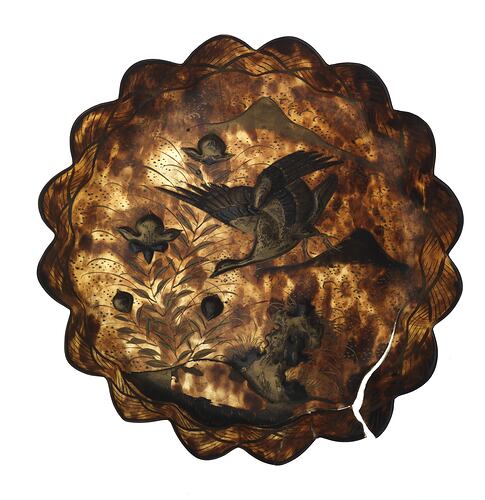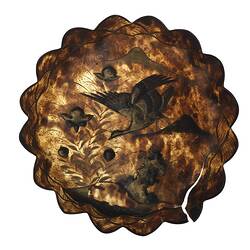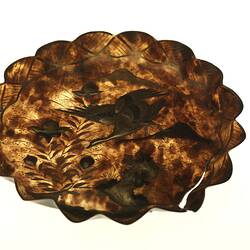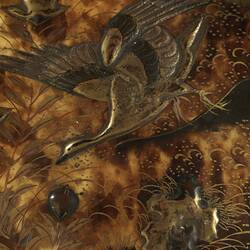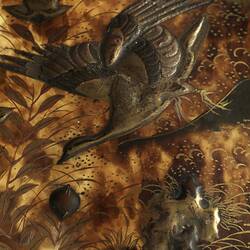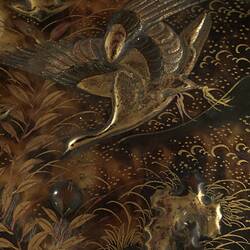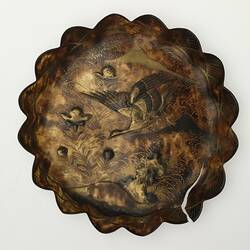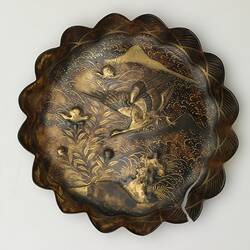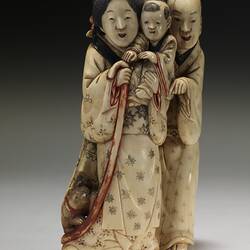Summary
Maki-e lacquer tortoiseshell plate with goose and autumnal flowers inlaid design, signed Yamabun, and manufactured in Nagasaki, Kyushu Region, Japan, during the early Meiji Period, circa 1868-1880.
Maki-e lacquering is a Japanese technique of sprinkling fine gold or silver powder into a design laid out in lacquer, using small brushes or bamboo tubes to create fine, often highly detailed and intricate designs. Other metals could be employed to achieve different colours, such as brass, copper, plantinum, pewter, as well as other alloys. The technique was first developed during the Heian period (794-1185) and flourished as a decorative style during the Edo period (1600-1868).
The beautiful decorative work of maki-e lacquer ware, combined with the increasing interest in the West of things Japanese, made such items as this incredibly popular for export markets. One advertisement, appearing in Melbourne's Argus newpaper in December 1880 some months after the International Exhibition had opened, promoted the sale of Japanese art exhibits 'just arrived from Japan. Collected specially by a gentleman resident in Japan for 14 years, for the Melbourne International Exhibition, but shut out in consequence of arriving too late for admission.' The advertisement continued by noting the 'very beautiful assortment of porcelain and lacquer ware, arranged in lots specially suitable for Christmas presents'.
Physical Description
Shallow, translucent dish made from tortoise shell with fluted rim. Inlaid with flying bird and flowers, highlighted in gilt, and signed on the underside.
More Information
-
Collection Names
-
Collecting Areas
-
Acquisition Information
Cultural Gifts Donation from Dr Will Twycross, 23 Jan 2009
-
Acknowledgement
Donated through the Australian Government's Cultural Gifts Program
-
Place & Date Made
Nagasaki, Kyushu, Japan, circa 1880
early Meiji Period; Edo Period, 1603-1867; Meiji Period, 1868-1912 -
Place & Date Exhibited
Royal Exhibition Building (REB), Nicholson Street, Carlton, Greater Melbourne, Victoria, Australia, 1880-1881
-
Collector
Mr John Twycross, Elsternwick, Greater Melbourne, Victoria, Australia, 1880-1881
-
Inscriptions
Signed on underside: Yamabun (kanji character under a mountain)
-
Classification
Royal exhibition building, International exhibitions, Exhibition heritage
-
Category
-
Discipline
-
Type of item
-
Overall Dimensions
155 mm (Width), 15 mm (Height)
-
Maximum dimensions
21 mm (Height), 152 mm (Outside Diameter)
Measurement From Conservation.
-
References
Argus, Monday, 29 November 1880, p.2
-
Keywords
Decorative Arts, Exhibitions: Melbourne International, 1880-1881, Japanese Art, Lacquerware, Royal Exhibition Building, Tortoiseshell
